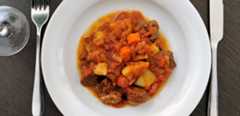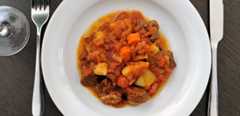Pörkölt Recipe for the Stew Formerly Known as Goulash from Hungary
This post may contain affiliate links. If you make a purchase through links, we may earn a commission.
This pörkölt recipe from Budapest, Hungary, makes the stew that most people know as goulash. When we first visited Budapest, my knowledge of Hungarian food and wine was limited to Bull’s Blood red wine, Tokaji sweet wine, salami, paprika, and the dish that was made using paprika – goulash.
Given that I’ve been stewing and braising away this year – making everything from thebredie in Cape Town, Frenchcassoulet, Spanishoxtail stew, and Moroccanlamb tagine with prunes and almonds – coupled with the fact that fluffy flakes of snow were starting to swirl around the courtyard of the gorgeous Budapest building that’sour latest home away from home, goulash appeared to be the perfect dish to make for our series The Dish on the quintessential dishes of places.
There was only one problem. When we arrived inBudapest fromIstanbul, we discovered that goulash didn’t turn out to be the dish I thought it was going to be. Anyone with even the slightest interest in what’s on their plate at meal time has heard of ‘Hungarian goulash’, but the dish doesn’t really exist – at least not in the form people who can’t speak Magyar (the notoriously difficult Hungarian language) think.
Update: if you love a good stew, do browse ourbest stew recipes including recipes for thisold-fashioned chicken stew, aRussian beef stew called Solyanka, atraditional Irish beef stew, anIrish beef and Guinness stew with dumplings, aCambodian pork stew with star anise and ginger, and mychorizo, cabbage and three bean stew.
Pörkölt Recipe for the Stew Formerly Known as Goulash from Budapest, Hungary
Goulash (gulyás) is actually soup andgulyás means ‘herdsman’. The dish that most people are thinking of when they imagine ‘Hungarian Goulash’ is a stew with a similar flavour to the soup calledpörkölt. Whilegulyás is made exclusively from beef,pörkölt can be made with other meats.
So when you go to that Hungarian restaurant and you ordergulyás and get a stew, that’s the waiter recognising that you’re a foreigner and assuming that you don’t actually want the soup, but the stew. While he’s being kind, it’s not really helpful because it’s keeping the myth alive. Some menus we saw in Budapest listedgulyás as ‘goulash (soup)’, which goes part of the way to helping clarify the issue.
Everygulyás orpörköltwe tried did have one thing in common, they were absolutely delicious. At the Christmas Markets, in fine dining restaurants, and at old favourites, the smoky earthiness of the paprika is what sets these dishes apart from other stews and soups.
Given the number of stews I’ve made this year, I decided to stick to makingpörkölt. Although as food writerCarolyn Bánfalvi (with whom we did aBudapest markets walk) says in her excellentFood Wine Budapesttome,pörköltis essentially gulyáswithout the broth.
Both are classic but humble dishes, that are famous not for their complexity in cooking, but for the incredible flavour and hearty texture. If you’re in Budapest and it’s snowing outside,pörköltor gulyáswith a glass of red is the perfect warming winter meal.
Tips to Making this Pörkölt Recipe for the Stew Formerly Known as Goulash
One of the reasons the dish is so humble is that there are so few ingredients. In the book,Cuisine of Hungary by George Lang (one that Carolyn recommended to me as a favourite), the ingredients are listed as veal, lard, onion, paprika, garlic, salt, tomatoes, and green pepper. And the garlic is optional! However, there are a couple of secrets to this dish…
Firstly, the paprika must be Hungarian and fresh – not from the back of the cupboard with a use-by date of 1996. We skipped the fancy displays at the market and bought some from the supermarket – less romantic but more practical as it’s actually more likely to be fresh, the busy supermarket having a higher turnover than the tourist displays in the market.
Paprika is one edible take-home that’s essential if you love to cook. We could easily write a feature story just on Hungarian paprika, as it comes in different heat levels, flavours (sweat, spicy), grinds, and colours. We like it hot, so I used a hotCsemege paprika. AlthoughÉdesnemes paprika is more common for stews, it’s a little light for me.
The second secret to the dish is that, as you can see from the ingredients above, there is no stock used, nor wine, or flour. Even if you’re makinggulyás,it’s water that is added. The ‘gravy’ for this dish comes from the onion and the meat – although you add a little water to stop things sticking occasionally.
Although not strictly sticking to the letter of thepörköltlore, I like to add carrots and potatoes – both additions that are fine forgulyás. Withpörkölt, potatoes are usually served on the side but I’ve never been a fan of plain boiled potatoes when they could be enhanced by a dip in the stew.
Many people also serve it with dumplings, but seriously, while it helps to make a balanced meal by providing carbohydrates, unless you are an actual herdsman who has done a day’s slog, you might find this to be too filling. I just like serving it with some decent bread.
Carolyn serves it with polenta orspätzle (egg noodle) and tells me that Budapest locals like to eat it with “pickled vegetables, and some hot paprika on the table so everyone can add as much (or little) heat as they like.”
If some guests find your version too hot, sour cream is your friend. Leave it in a dish on the table. If there is a Hungarian at the table they will now point out that the dish is now best called beefpaprikás. If you added some wine during cooking instead of water (I won’t tell anyone, it is delicious), you’ll be informed the dish is calledpincepörköltor ‘cellar stew’.
Whatever you call it, just don’t call it goulash, okay?
Pörkölt Recipe for the Stew Formerly Known as Goulash

Pörkölt (Hungarian Stew)
Ingredients
- 1 kilo stewing beef - cut into one inch dice
- 2 tbsp lard - I used rendered fat from a big block of delicious bacon
- 1 onion - minced
- 1 tbsp paprika
- 1 garlic clove - mashed
- 1 generous teaspoon salt - you can add more later if necessary
- 1 small tin of peeled tomatoes
- 1 green pepper - chopped finely
- 4 potatoes - quartered
- 4 carrots - sliced
Instructions
- Cook the onions in lard in a Dutch oven or casserole dish until lightly browned regardless. (Instead of lard, the diet-conscious could use some kind of neutral oil to cook the onions in but that would be a shame.)
- Take off the heat and add the paprika and garlic and stir through.
- Add the meat and salt and, over a lowish flame, stir until the meat starts to colour. If the meat starts to stick, add a little water.
- When the meat is browned, add the tomato and pepper and keep stirring.
- By now you should have enough liquid to leave the dish almost unattended, leaving you free to fend off hungry householders. And neighbours. The aroma is amazing.
- Every 10 minutes or so, check the dish and add more liquid as required, but just enough to stop it from burning.
- Cooking time should be around two to three hours.
- Par cook the carrots and potatoes in salted water and drain. Add just before serving.
- Serve with a decent bottle of red.
Nutrition
Please do let us know if you make this pörkölt recipe for the stew formerly known as goulash as we’d love to know how it turns out for you.
SHARE ON SOCIAL MEDIA
AUTHOR BIO
6 thoughts on “Pörkölt Recipe for the Stew Formerly Known as Goulash from Hungary”
Very interesting and well-written article. I am a little leery of the cooking technique. How does it not burn with so little water after two to three hours?
Dwight, “Every 10 minutes or so, check the dish and add more liquid as required, but just enough to stop it from burning.” You want a thick sauce with this, hence the minimal amount of water.
when do you add the carrots and potatoes?
Deb, par boil them and add just before serving.
Thanks for your comment.
TSuch a comforting, hearty dish! Really enjoyable.
Fantastic to hear, Abby! So pleased you enjoyed it!








